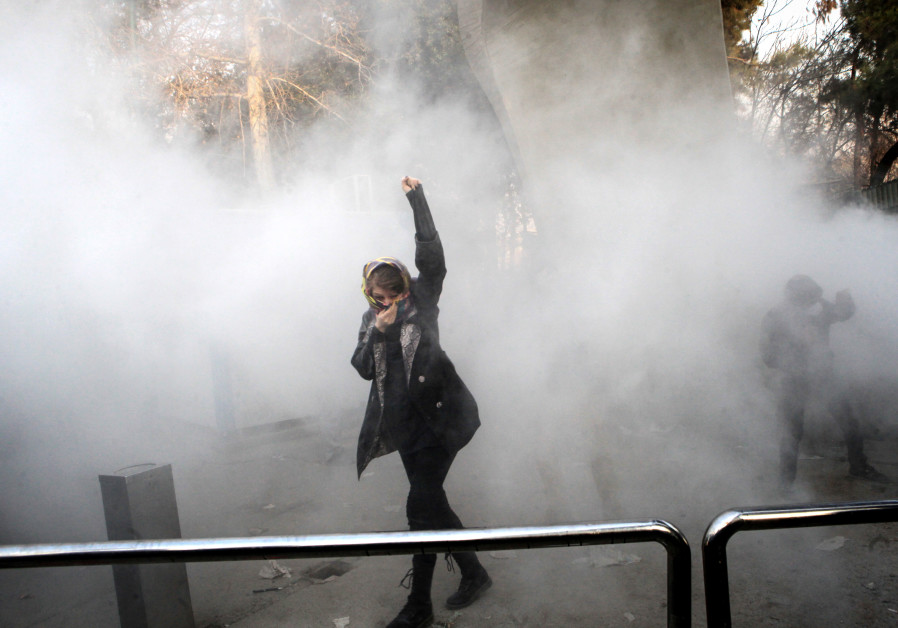Analysis: Iran reaches crisis point as U.S. sanctions return

An Iranian woman raises her fist amid the smoke of tear gas at the University of Tehran during a protest on December 30, 2017. (photo credit: STR / AFP)
WASHINGTON – Faced with a spiraling currency crisis, protests nationwide and the return of biting American sanctions on Monday, Iran’s government is poised to take a series of actions this week meant to project defiance abroad and control at home.
Protests that have slowly simmered since January spread last week to Iran’s largest cities, including Shiraz, Isfahan, and sporadically throughout Tehran itself, as corruption, mismanagement and external financial restrictions began to take their toll. The rial hit a new low as locals prepared for the US Treasury Department to cut off Iran’s access to the dollar, severely hampering the country’s ability to conduct basic financial transactions.
One man was shot dead in the city of Karaj protesting the dilapidated state of the economy while hundreds more were allegedly arrested in cities from Eshtehard to Arak, in a round of demonstrations covered by state-run media outlets largely dismissive of the movement thus far.
Last week, in a show of force to Washington and its Gulf allies, the Iranian Revolutionary Guard Corps’ naval forces conducted a drill in the Strait of Hormuz typically held later in the year and with an extensive publicity lead-up. Over 100 “swarming” boats practiced closing the critical strait, demonstrating Iran’s ability to “control and maintain the security of the international waterway” and “confront threats and potential adventurous acts of enemies,” an IRGC spokesman said on Sunday.
Over 20% of the world’s oil passes through the strait each day.
Then, on Saturday, the government approved plans by Iran’s Central Bank to limit access to official currency rates to essential imports and to restrict foreign currency access to local businesses. The emergency moves came as the rial hit 111,000 to the dollar, and marks part of a financial “rescue package” that Tehran plans to unveil in full on Monday, a Central Bank spokesman told local press, as the first round of US sanctions previously lifted under a 2015 international nuclear deal snap back into place.
In addition to cutting off Iran from dollars and gold, US sanctions enforced on Monday will also restrict Iran’s access to industrial metals and target the country’s automotive sector, its exports of carpets and its sale of pistachios.
(function(w,d,s,i){w.ldAdInit=w.ldAdInit||[];w.ldAdInit.push({slot:10834723912266086,size:[0, 0],id:”ld-9628-9059″});if(!d.getElementById(i)){var j=d.createElement(s),p=d.getElementsByTagName(s)[0];j.async=true;j.src=”//cdn2.lockerdomecdn.com/_js/ajs.js”;j.id=i;p.parentNode.insertBefore(j,p);}})(window,document,”script”,”ld-ajs”);
Washington’s harshest sanctions will come back into effect on November 4, by which date the Trump administration hopes to decimate Iran’s oil export market.
Cash strapped and desperate, Tehran has reportedly sought to withdraw funds parked overseas with limited success. According to The Wall Street Journal, Iran may lose access to $400 million of its money sat in a German account if Berlin proceeds with a new financial rule that would bar transactions adversely affecting its relationship with fellow central banks and institutions – in particular, the Federal Reserve and Treasury Department.
Iran did receive five French-made turboprop planes over the weekend for its domestic commercial fleet, marking what may be Tehran’s last tangible benefit from its nuclear agreement with world powers. That 2015 accord – brokered with France, Britain, Germany, Russia, China, and the US – had exchanged caps on Iran’s nuclear work for international sanctions relief.
Since US President Donald Trump withdrew from the agreement in May, businesses that were testing the waters in Iran have largely fled, fearing instability and a cutoff from the US financial system.
Iranian officials say they may pull out of the agreement themselves, or begin enriching uranium anew, unless Europe can guarantee it the benefits it was promised under the nuclear deal. To that end, talks between Tehran and European powers have stalled.






Comments are closed.